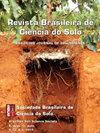Spatial multivariate optimization for a sampling redesign with a reduced sample size of soil chemical properties
IF 2
4区 农林科学
Q3 SOIL SCIENCE
引用次数: 1
Abstract
: Precision agriculture can improve the decision-making process in agricultural production, as it gathers, processes and analyzes spatial data, allowing, for example, specific fertilizer application in each location. One of the proposals to deal with spatial heterogeneity of the soil or the distribution of chemical properties is to define application zones (homogeneous subareas). These zones allow reducing both spatial variability of the yield of the crop under study and of the environmental impacts. Considering the soil data, application zones can also represent strata or indicators to direct future soil sampling, thus seeking sample size reduction, for example. This study aimed to obtain an optimized sampling redesign using application zones generated from the assessment of five clustering methods (Fuzzy C-means, Fanny, K-means, McQuitty and Ward). Soil samples were collected in an agricultural area located in the city of Cascavel-Paraná-Brazil, and analyzed in the laboratory to determine the soil chemical properties, referring to four soybean harvest years (2013-2014, 2014-2015, 2015-2016 and 2016-2017). The application zones were obtained through a dissimilarity matrix that aggregates information about the Euclidean distance between the sample elements and the spatial dependence structure of the properties. Subsequently, an optimized sampling redesign, with reduction of the initial sample points, was obtained in these application zones. For the harvest years under study, the K-means and Ward clustering methods efficiently defined the application zones, dividing the study area into two or three application zones. Among the reduced sample configurations obtained by the optimization process, when comparing the initial sample configuration, the one optimized by 25 % (selecting 75 % of the initial configuration points, which corresponds to 76 sample points) was the most effective in terms of the accuracy indices (overall accuracy, Kappa, Tau). This fact indicates greater similarity between the thematic maps of these sample configurations. In this way, the reduced sample configurations could be used to generate the application zones and reduce the costs regarding the laboratory analyses involved in the study.减少土壤化学性质样本数量的采样重新设计的空间多元优化
本文章由计算机程序翻译,如有差异,请以英文原文为准。
求助全文
约1分钟内获得全文
求助全文
来源期刊

Revista Brasileira De Ciencia Do Solo
农林科学-土壤科学
CiteScore
3.00
自引率
11.80%
发文量
32
审稿时长
9-24 weeks
期刊介绍:
The Revista Brasileira de Ciência do Solo is a scientific journal published by the Brazilian Society for Soil Science (SBCS), founded in 1947, and is responsible for the propagation of original and inedited technical-scientific work of interest for Soil Science.
Contributions must not have been previously published or submit to other periodicals, with the only exception of articles presented in summarized form at professional meetings. Literature reviews are accepted when solicited by the Editorial Board.
 求助内容:
求助内容: 应助结果提醒方式:
应助结果提醒方式:


